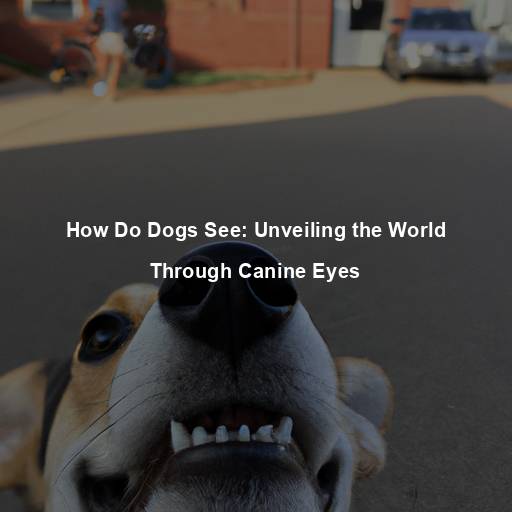How Do Dogs See: Unveiling the World Through Canine Eyes
Last Updated on July 25, 2023 by Evan
Contents
The Wonders of Canine Vision
There is something truly captivating about dogs, isn’t there? Those loyal and cuddly creatures have dazzled us with their curious ways and distinct points of view. It’s no wonder that one aspect of their lives keeps us utterly perplexed – their extraordinary way of perceiving the world. As humans, we rely heavily on our eyes to grasp the surroundings, but have you ever stopped to ponder how dogs see it all?
Understanding the Basics
To comprehend how dogs see, we must first acknowledge the differences between their visual system and ours. Dogs belong to a group of animals known as dichromats, meaning they have two types of color receptors in their eyes, compared to our trichromatic vision. While humans perceive a broad spectrum of colors, dogs primarily see the world in shades of blue and yellow. Reds and greens appear more muted to them, blending into a somewhat monochromatic palette.
The Power of Night Vision
One of the most remarkable aspects of canine vision is their exceptional ability to see in low-light conditions. Dogs possess a higher number of rod cells in their retinas, specialized photoreceptor cells responsible for detecting light levels. This abundance of rods grants them superior night vision compared to humans. It’s no wonder that dogs excel in activities such as hunting and surveillance during dimly lit hours.
The World of Smells and Scents
In a world where sight reigns supreme, it’s easy to overlook the extraordinary power of a dog’s nose. Behind those adorable snouts lies an olfactory wonderland, equipped with a staggering 220 million scent receptors, far surpassing our own meager 5 million. With this remarkable sense, dogs dive deep into a symphony of smells, unraveling the intricacies of aromas that evade our human senses. So, while we marvel at the visual wonders around us, let’s not forget that our canine companions are navigating a truly enigmatic world, where scents and sights collide in a burst of perplexing brilliance.
Canine Depth Perception
Depth perception allows us to perceive distance and three-dimensional space accurately. Although dogs have excellent motion detection, their depth perception is not as refined as ours. Their snouts and facial structure, while adorable, limit the field of view and binocular vision, which plays a crucial role in depth perception. However, dogs compensate for this limitation by relying on other visual cues, such as motion parallax and object size, to navigate their surroundings effectively.
The World of Motion
There’s something fascinating about dogs and their almost hypnotic fixation on anything that moves. It’s like they have this built-in superpower to detect motion at an astonishing level, surpassing our human capabilities. While we perceive movement at a mere 60 frames per second, these four-legged wonders navigate the world at an incredible rate of 70-80 frames per second. This uncanny sensitivity to motion makes them unrivaled partners when it comes to sports, hunting, and any activity that requires sharp tracking skills.
Adaptations for Survival
Over time, dogs have undergone an incredible transformation, mastering the art of visual perception for their very existence. Amidst this mesmerizing journey, they have stumbled upon a remarkable adaptation known as the tapetum lucidum. Hidden within their retinas, this enigmatic reflective layer serves as a mystical mirror, channeling every ray of light back into their eyes, elevating their nocturnal vision to extraordinary levels. Moreover, these astute creatures possess a cleverly positioned pair of eyes that bestows upon them a panoramic perspective, enabling them to detect danger or opportunity from countless angles.
The Influence of Breed
Just like people, dogs see the world in their own quirky ways. It’s fascinating to discover that not all dogs have the same visual abilities. From their eye shape to their genetic background, there are so many factors that can influence how they perceive their surroundings. For example, those adorable brachycephalic breeds with their short and wide skulls may have some visual impairments to contend with due to their special facial structure.
The Unwavering Bond
As we delve into the fascinating realm of understanding canine vision, it becomes clear that our furry friends behold a world imbued with a charming mix of adoration and steadfast devotion. Beyond the intricate details of their visual prowess, dogs remain steadfast by our side, forging bonds that transcend the limitations of sight. Through their eyes, we witness a kaleidoscope of affection and loyalty, a lens through which the essence of simplicity and the potency of companionship are laid bare, leaving us in awe of their profound ability to love unconditionally.
Unveiling the Canine Perspective
With their captivating ability to perceive the world through a kaleidoscope of colors unseen by humans, dogs invite us to explore a realm filled with perplexing wonder. As we delve into their extraordinary night vision and navigate their olfactory labyrinth, a symphony of scents unfolds before our senses, revealing a universe shrouded in enigmatic allure. Yet, amidst this sense-studded tapestry, the essence of dogs remains unaltered – a profound capacity to shower us with boundless joy, unwavering companionship, and an immeasurable reservoir of love. Let us indulge in the ethereal beauty of their visual tapestry, for within their gaze lies a gateway to a world teeming with enchantment, an eternal bond between humanity and our loyal canine counterparts.
Stay tuned for more captivating stories, expert advice, and heartwarming tales at PetsRoof.com: Your Go-To Source for All Things Pets!## Exploring Canine Color Vision
The Spectrum of Colors
While dogs possess a limited color vision compared to humans, it is important to understand how they perceive the world of colors. Dogs primarily see shades of blue and yellow, but their ability to distinguish between different hues is not as pronounced as ours. Reds and greens appear more muted to them, blending into a somewhat monochromatic palette. However, this doesn’t hinder their overall perception of the world, as their senses extend far beyond the realm of colors.
Beyond Colors: The Power of Scent
While humans rely heavily on visual cues, dogs navigate the world through their exceptional sense of smell. Their olfactory capabilities are far superior to ours, allowing them to detect scents and odors that elude our perception. For dogs, the world is a symphony of smells intertwined with their visual experiences. They can detect a myriad of scents, from the faintest aroma to the most intricate of odors, providing them with a more comprehensive understanding of their surroundings.
Perceiving Depth and Movement
The Challenge of Depth Perception
Exploring the enigmatic world of depth perception, we delve into the captivating realm where distance meets three-dimensional mystique. In this mesmerizing journey, we decipher the intricate nuances that set humans and our beloved canine companions apart. Gracefully adapting to life’s labyrinth, dogs, with their snouts and intriguing facial structure, encounter a peculiar challenge: a limited field of view and a divergent level of binocular vision, essential for unraveling depth’s enigmatic tapestry. Yet, in their unwavering determination, our furry friends masterfully employ a symphony of visual cues – motion parallax and object size among them – orchestrating a vibrant dance that grants them unfailing navigation prowess and a profound connection to their captivating environment.
Masters of Motion Detection
Dogs possess an uncanny knack for honing in on motion, a truly remarkable skill that sets them apart from us mere humans. Their radar-like precision in detecting movement, coupled with their ability to process visual stimuli at a lightning-fast pace, gifts them with an extraordinary advantage in perceiving the world around them. This extraordinary aptitude plays a vital role in their prowess when it comes to pursuits like catching flying frisbees or chasing squirrels through sprawling yards. Their unrivaled ability to detect dynamic shifts is undoubtedly a contributing factor to their unrivaled success in diverse activities, including but certainly not limited to sports, search and rescue missions, and, of course, the art of hunting.
Unique Adaptations for Visual Acuity
The Tapetum Lucidum
The awe-inspiring wonders of a canine’s visual system never cease to amaze. Among its many extraordinary adaptations, the tapetum lucidum takes center stage. Nestled behind the retina, this reflective layer acts as a secret mirror, cleverly bouncing incoming light back onto the retina to optimize its utilization. As a delightful bonus, it bestows our furry friends with that enchanting glow in their eyes, aptly named “eye shine”.
Field of View and Peripheral Vision
When it comes to doggie eyesight, there’s more to it than meets the human eye. One fascinating aspect is their wide-ranging field of view. Unlike humans, dogs have eyes placed on the sides of their head, giving them an impressive peripheral vision. This advantage allows them to spot potential dangers or enticing prey from various angles, keeping them on high alert.
Breed-Specific Variations
The Influence of Genetics
While dogs, as a species, share common visual traits, it is important to acknowledge that different dog breeds may exhibit variations in their visual abilities. Factors such as eye shape, size, and genetic heritage can influence how dogs perceive the world. For instance, brachycephalic breeds with short and wide skulls may experience visual impairments due to their unique facial structure. Understanding these breed-specific differences can help us address any potential visual challenges and ensure the well-being of our furry friends.
Vision and Eye Health
Keeping our furry friends in good health is a top priority for any conscientious pet owner. When it comes to our loyal canine companions, taking care of their eyes is just as important as keeping their tails wagging. While our four-legged friends may not be able to tell us when something is wrong with their vision, regular check-ups with a trusted veterinarian can help catch any early signs of trouble. Certain breeds may be more susceptible to specific eye conditions, which can range from cataracts to glaucoma, or even progressive retinal atrophy.
The Beauty of Canine Perspective
Embracing the Canine Worldview
As we embark on a quest to unravel the mysterious ways in which our canine companions view the world, we are faced with a fascinating conundrum. In their fascinating exploration of the environment, dogs provide us with a kaleidoscope of sensory insight that defies our conventional understanding. By delving into their unparalleled olfactory prowess, their uncanny knack for detecting motion, and their remarkable adaptations for survival, we are beckoned into an enigmatic realm that transcends the realm of mere visual perception. In this captivating journey, we unravel the intricate tapestry of their perception, allowing us to marvel at nature’s wonders and deepening our appreciation for the profound bond that exists between humans and their four-legged friends.
A Lesson in Unconditional Love
In the realm of perceiving the world, dogs possess a unique vision that surpasses the boundaries of a mere visual spectrum. Their profound ability to behold the world with pure affection, undying faithfulness, and unwavering camaraderie is a marvel in itself. Let us marvel at the sheer wonder of canine vision, reminding us of the elegance in the unadorned and the sheer bliss of communal encounters. May we hold dear the instants we partake in with our four-legged companions, as we revere the captivating union that defies the limits of sight.
Stay tuned for more captivating stories, expert advice, and heartwarming tales at PetsRoof.com: Your Go-To Source for All Things Pets!
FAQs for How Do Dogs See:
What determines how dogs see?
Dogs have a different visual perception compared to humans, influenced by several factors. One of the key factors is the arrangement of their eyes on the front of their head, providing them with binocular vision and depth perception. Dogs also have a higher concentration of rod cells in their retinas, which allows them to see better in low light conditions but results in a decreased ability to perceive fine details or distinguish colors as vividly as humans. Additionally, the shape and structure of their eyes, as well as their lens, affect how dogs perceive the world visually.
Can dogs see color?
Have you ever wondered how dogs see the world around them? It turns out that they do have the ability to see colors, but their color vision is not quite the same as ours. While humans have three types of color receptors, known as cones, in their eyes, dogs only have two. This means that they have what is called dichromatic color vision, limiting their perception of the color spectrum. For dogs, the world is a burst of vivid blues and yellows, with greens and reds appearing as shades of these colors or even as dull grays. It’s truly fascinating how different species perceive the same world in such perplexing ways!
How do dogs see at night?
Dogs have superior night vision compared to humans due to the presence of a higher number of rod cells in their retinas. Rod cells are responsible for vision in low-light conditions and motion detection. This allows dogs to perceive objects in dim lighting that would otherwise be difficult for humans to see. Additionally, a structure called the tapetum lucidum, located behind their retina, reflects light back through their retina, giving them a boost in their night vision capabilities.
Do dogs see better in the dark?
Dogs possess an incredible night vision that leaves us humans feeling a little envious. With a higher density of rod cells in their eyes, they have the uncanny ability to navigate effortlessly in low-light situations. This heightened acuity allows them to be masters of detecting even the slightest motion and objects lurking in the shadows. Nevertheless, let’s not forget that dogs, just like us, still need a smidge of ambient light to skillfully maneuver their surroundings. It’s truly fascinating how these furry beings have adapted to perceive the world in ways that perplex our own limited senses.
Can dogs see in color at all?
Have you ever wondered how dogs see the world? It turns out that their color vision is not quite on par with our human technicolor experience. While dogs do have the ability to see colors, it’s like they’re viewing life through a vintage filter. Their vision relies more on shades of blue and yellow, with a limited range of hues. But here’s the twist: not all dogs see the same colors! Just like humans, their perception can be as unique as their adorable personalities. It’s a fascinating world of canine visual perplexity that we’re just starting to unravel.
Do dogs see TV or computer screens?
It’s no secret that dogs are captivated by the glowing screens of TVs and computers, but what they see on those screens may not be what we humans perceive. Dogs possess an uncanny ability to detect the rapid refresh rate of these displays, causing the images to take on a peculiar flickering effect. This burst of visual stimulus can leave our furry friends perplexed, as the visuals seem to morph into a series of frozen snapshots. However, some dogs do manage to find interest in certain programs or videos where animals are in motion or emit sounds, as they can grasp the motion and sounds amidst the baffling flickering spectacle.







